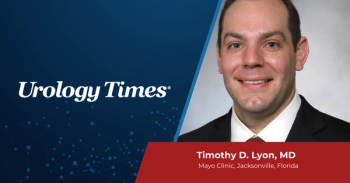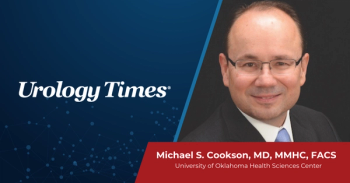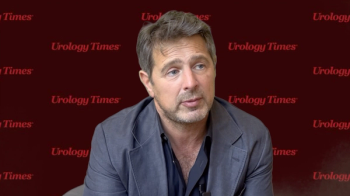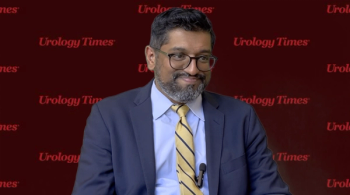
Experts outline Northwestern’s oncofertility program

"When we think about medical fertility preservation, it really is an all-hands-on-deck type of situation," says Kristin Smith, MD.
In this video, Robert E. Brannigan, MD; Kristin Smith, and Joshua A. Halpern, MD, MS, discuss the oncofertility program at Northwestern University in Chicago, Illinois.
Transcription:
Brannigan: My name is Robert Brannigan, and I'm a professor in the department of urology at Northwestern University Feinberg School of Medicine, and Northwestern Medicine here in Chicago. I'm also very involved with the andrology fellowship here at Northwestern.
Smith: I'm Kristin Smith. I'm the program manager for fertility preservation here at Northwestern. My day-to-day is to see patients right when they've been diagnosed with cancer or another disease that we know the treatment of which could impact fertility. I take these patients, walk them through the impact that their treatment will have on fertility and then what fertility preservation options exist for them.
Halpern: I am Josh Halpern. I'm a reproductive urologist at Posterity Health and also on faculty at Northwestern University, part of the fellowship, along with Dr. Brannigan and really involved in the research component of the andrology program.
Brannigan: For the longest time within the field of medicine, broadly, when it came to cancer, the thought was that the focus should be single handedly on the treatment and eradication of cancer within patients with that as a single focus. The problem with that approach is that there are many downstream adverse effects for patients. We now know that over half of males of reproductive age will survive their cancer. Cancer therapies are amazing, but unfortunately, in their wake, they leave many devastating consequences for patients, including impaired fertility. Infertility was something that for many patients, it was just assumed were going to have to deal with and live with as cancer survivors. But in the early 2000s, there was a lot of movement from the President's Cancer Panel, and also from ASCO [the American Society of Clinical Oncology], to address this issue and ultimately put forth guidelines recommending that fertility preservation be considered upfront at the time of a cancer diagnosis, and that fertility preservation efforts be implemented clinically, before cancer treatments were given. Initially, I think in some arenas, there was some concern or pushback about fertility preservation care getting in the way of or blocking or obstructing cancer care. Really, that couldn't be further from the truth with people like Kristin Smith, who's on this call and Dr. Halpern, my colleague has done really a lot of work with very tricky clinical situations where the timelines were tight. I think we found time and time again that we're able to implement provide this care in a timely and seamless fashion that does not interfere with the delivery of cancer therapies.
Smith: When we think about medical fertility preservation, it really is an all-hands-on-deck type of situation. We know that for many patients, we need to tap into a multitude of specialties. For patients with testicles, we are tapping into our reproductive urology team so that they can be seen quickly for a consult, they can talk about the fertility preservation options that are available, and then get these patients in quickly for either sperm banking or a surgical procedure. For our patients with ovaries, we know that they need to see reproductive endocrinology quickly and in those cases be seen to talk about something like egg or embryo banking, maybe having medications added to their chemotherapies to potentially help protect from the gonadotoxic effects of their treatments. And then there's a whole host of other specialties that really should be involved with these patients. They're complex; they've got a lot of needs. We know that young adults with cancer experience their cancer a lot different than pediatric patients or their older adult cohorts. And so, we really love to tap into our supportive oncology team to help with psychotherapy, dietary therapy, and social work, which has been a huge, huge asset to us as well. And then we also have our psychologists within reproductive endocrinology who are so helpful to so many of our patients who have a difficult time going through this process in the wake of a cancer diagnosis. We also work really closely with our medical social sciences team and our researchers, who are at the forefront of making sure that we're providing the best care that we can for these patients and that we are making sure that we are offering our patients everything that's out there that we've got access to, so that our patients know in a comprehensive way they're being taken care of, not just with cancer, but as a whole person.
Halpern: It's a very exciting time for the field of oncofertility in a lot of ways from a research perspective. The research spans translational efforts, which I'll get into a little bit, which are really very, very exciting and potentially game changing, and also care delivery efforts, access to care efforts. There have been some recent studies showing that we're really just not doing what we need to be doing as far as access to care goes for a lot of patients who do need oncofertility, and so are there innovative ways to deliver that care through extenders, through telehealth and other potential legislative actions, which Kristin has been integrally involved in over the years. That part has been really exciting. But the translational piece is probably the most exciting. This really centers around the prepubertal patient because we often will see young children before puberty, unfortunately receive a cancer diagnosis before they're at the stage of having spermatogenesis—mature sperm production. And so that makes it very tricky. These patients are not able to produce a sample that we can cryopreserve for future use. And so a lot of the translational efforts have focused on that patient population. A really exciting paper from a few years ago led by Kyle Orwig [PhD], in a multidisciplinary effort out of the University of Pittsburgh actually showed in a group of rhesus monkeys that they were able to take prepubertal testicular tissue and graft it back on to those monkeys, and actually grow not only mature sperm from that tissue, but ultimately use that sperm for IVF [in vitro fertilization] successfully to have a healthy offspring. That was really, really a game changer in our field. Since then, we're starting to see some more research along those lines in the prepubertal space. There was an abstract presented the 2023 AUA [American Urological Association] meeting, which was not quite an oncofertility-focused abstract, but harvesting of testicular tissue from prepubertal patients who were in the queue to undergo hormone therapy for transgender affirming care. And so these were patients who hadn't yet gone through puberty and were intended to undergo puberty blockers. They did testicular tissue biopsies from these patients, and they were actually able to cultivate spermatogonial stem cells from just about every one of these patients. So again, lots of good translational work, not yet ready to make it into primetime, so to speak, not ready for clinical implementation, but certainly on the horizon and something that has us very excited for that patient population that is prepubertal and really challenging to treat.
Brannigan: I think it's so important, as Kristin already mentioned, to make sure that you have a team approach. It's not just the clinicians; it's not just the urologist or the reproductive endocrinologist. Obviously, the oncologists need to have buy-in and they need to be willing to let their patients be referred for care. Also, the clinical teams, both inpatient and outpatient, the nurses who help to deliver care are very important in making this happen, both for inpatients and outpatients. And certainly the laboratory staff. These patients and their needs for fertility preservation are not limited to times between 9 and 5. And so, laboratories having flexibility in providing the care is super important. And also labs that are talented and skilled at working with small amounts of sperm. Very often, our patients are grappling with cancer and in return, their body will unleash a pretty substantial immune response. That immune response sometimes will include fevers and other immune issues will drive down sperm production. And so, very often, the samples these patients are providing have very low numbers of sperm, so having a lab that's talented at working with small numbers of sperm is really important as well.
Smith: I think it's important that especially when you're first starting a program that you make yourself available, to make sure that all the clinics know what's going on. For us at Northwestern, we've tried really hard to make the process for referrals for fertility preservation as easy as possible. By having them come through a central navigator, that's been super helpful, [so] our oncology providers know they don't need to be the experts when it comes to fertility preservation. I've got the experts sitting right here. All that they need to do is get that patient to me and then know that your reproductive partners are going to get these patients in quickly. Building that first is huge and then allowing these patients to have a smooth transition as they go through medical fertility preservation.
Halpern: I would just add that having a truly formalized program does translate into outcomes. Just to call out Kristin and Dr. Brannigan were coauthors on a paper that's now, believe it or not, over 10 years old, documenting the establishment of Northwestern's fertility preservation program for male patients with cancer. It really needs to be formalized; there were a number of different interventions, a lot of the ones listed here that were implemented in a very formal way. But when you do that, you really can see results. And so they showed that there was an increased utilization of fertility preservation consults, increased utilization of sperm cryopreservation, and so we really do have the data to back up the fact that when you implement something in a formal way, in a multidisciplinary way, it really does improve access and improve care for our patients.
Brannigan: I want to add that this work can be challenging logistically. Sometimes, the patients also find it a challenge. It can be an extra thing in their very busy schedule. But as Dr. Halpern and Kristin will tell you, the alternative is for us, down the road, to be sitting in a clinic appointment with these same patients having gone for semen testing showing no sperm present, and finding that their opportunities for biological paternity are very limited. Sometimes, we can take those patients to the OR and surgically extract sperm, but even then, a lot of times, the patients won't have anything on attempted sperm extraction. I think the take-home message is that our patients expect a lot out of us, and these survivorship issues, like fertility preservation, are really, really important to patients. They want to live a full and happy life; there's an abundance of literature showing that our patients want this and appreciate it. And taking a little bit of time on the front end to provide this care in the midst of other cancer care is really important and ultimately greatly appreciated by our patients.
Smith: I think it helps when you've got a team like these guys to work with who give up their time so selflessly. They do add-ons for us when patients need to be seen urgently, and you don't get that at every academic medical center. From the fertility preservation standpoint, we feel so grateful that we have such great partners in our physicians, our APPs, even our administration, which has been so supportive of this program and has had this program rolling for the past 13 years. It wouldn't happen without all these different people involved and all this different support that we have, and we're really grateful to all of them.
This transcription was edited for clarity.
Newsletter
Stay current with the latest urology news and practice-changing insights — sign up now for the essential updates every urologist needs.


















